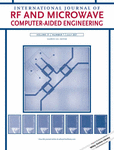A 18-23 GHz power amplifier design using approximate optimal impedance region approach for satellite downlink
Funding information: China Postdoctoral Science Foundation, Grant/Award Number: 2019M663930XB; National Key Research and Development Program of China, Grant/Award Number: 2018YFB1802104; National Science and Technology Major Project, Grant/Award Number: 2019ZX01001101
Abstract
This paper presents the design procedure of a K-band 0.1 μm GaAs pseudomorphic high electron mobility transistors (pHEMT) monolithic microwave integrated circuit (MMIC) for satellite communication downlinks. The method focuses on the selection and design of the matching network (MN) by applying the Approximate Optimal Impedance Region (AOIR) approach which is a composition of simple mathematical constraints. The AOIR approach overcomes the drawbacks of traditional MN design method which cannot control the reflection coefficient trajectory of the MN precisely. The method formulates the constraints through symbolic-graphic combinations with integrated functions of computer-aided design (CAD) tools. The impedance transformation trajectory of MN is combined to reduce the mismatch and the insertion loss using equations with multiple mathematical constraints to realize the automatic selection of the MN's topology. The AOIR method fully considers the underutilized characteristics of power amplifier (PA) and to maximize its performance in a balanced manner. The MMIC, was designed using the proposed technique, operates in 18 GHz-23 GHz with a gain of 27 dB and has an average P−1dB of 27 dBm and PAE of 38% under the continuous wave (CW) drive signal.




